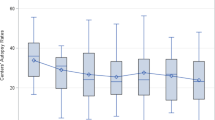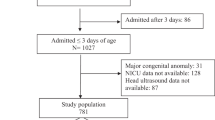Abstract
Objective
To identify patterns of neuroimaging (NI), including cranial ultrasounds (CUS) and magnetic resonance imaging (MRI), among a large cohort of United States NICU infants.
Study design
The retrospective cohort study of the Pediatrix Clinical Data Warehouse for infants discharged between 2008 and 2017.
Results
From the 863,863 infants during the study period, 204,197 (24%) had at least one NI study. CUS was the most common study (n = 189,190, 22%) followed by MRI (n = 37,107, 4%). From 2008 to 2017, the percentage of infants who underwent any NI decreased from 28 to 21% (p < 0.001) driven primarily by a reduction in CUS. MRI use for infants ≤33 weeks increased through 2015 and then decreased.
Conclusions
Overall reductions in NI have been driven by decreased use of CUS in infants born at 31–33 weeks’ gestational age. MRI use among preterm infants has been more dynamic with an initial rise and recent decrease.
This is a preview of subscription content, access via your institution
Access options
Subscribe to this journal
Receive 12 print issues and online access
$259.00 per year
only $21.58 per issue
Buy this article
- Purchase on Springer Link
- Instant access to full article PDF
Prices may be subject to local taxes which are calculated during checkout





Similar content being viewed by others
References
Barnes PD. Neuroimaging and the timing of fetal and neonatal brain injury. J Perinatol. 2001;21:44–60.
Neil JJ, Inder TE. Imaging perinatal brain injury in premature infants. Semin Perinatol. 2004;28:433–43.
Hintz SR, O’Shea M. Neuroimaging and neurodevelopmental outcomes in preterm infants. Semin Perinatol. 2008;32:11–9. https://doi.org/10.1053/j.semperi.2007.12.010.
Ment LR, Bada HS, Barnes P, et al. Practice parameter: neuroimaging of the neonate: report of the Quality Standards Subcommittee of the American Academy of Neurology and the Practice Committee of the Child Neurology Society. Neurology. 2002;58:1726–38.
Neuroimaging of the Neonate. Am Acad Neurol. 2018. https://www.aan.com/Guidelines/Home/GuidelineDetail/78. Accessed July 30, 2019.
Ho T, Dukhovny D, Zupancic JA, Goldmann DA, Horbar JD, Pursley DM. Choosing wisely in newborn medicine: five opportunities to increase value. Pediatrics. 2015;136:e482–9. https://doi.org/10.1542/peds.2015-0737.
Spitzer AR, Ellsbury DL, Handler D, Clark RH. The Pediatrix BabySteps Data Warehouse and the Pediatrix QualitySteps improvement project system—tools for “meaningful use” in continuous quality improvement. Clin Perinatol. 2010;37:49–70. https://doi.org/10.1016/j.clp.2010.01.016.
Natarajan G, Shankaran S, Saha S, Laptook A, Das A, Higgins R, Eunice Kennedy Shriver National Institute of Child Health and Human Development Neonatal Research Network. et al. Antecedents and outcomes of abnormal cranial imaging in moderately preterm infants. J Pediatr. 2018;195:66–72.e3. https://doi.org/10.1016/j.jpeds.2017.11.036.
Routine screening cranial ultrasound examinations for the prediction of long term neurodevelopmental outcomes in preterm infants. Paediatr Child Health. 2001;6:39–52. https://doi.org/10.1093/pch/6.1.39.
Hintz SR, Vohr BR, Bann CM, Taylor HG, Das A, Gustafson KE, et al. Preterm neuroimaging and school-age cognitive outcomes. Pediatrics. 2018;142:e20174058. https://doi.org/10.1542/peds.2017-4058.
Woodward LJ, Anderson PJ, Austin NC, Howard K, Inder TE. Neonatal MRI to predict neurodevelopmental outcomes in preterm infants. N Engl J Med. 2006;355:685–94.
Horsch S, Skiöld B, Hallberg B, et al. Cranial ultrasound and MRI at term age in extremely preterm infants. Arch Dis Child Fetal Neonatal Ed. 2010;95:F310–4. https://doi.org/10.1136/adc.2009.161547.
Hintz SR, Barnes PD, Bulas D. Support Study Group of the Eunice Kennedy Shriver National Institute of Child Health and Human Development Neonatal Research Network, et al. Neuroimaging and neurodevelopmental outcome in extremely preterm infants. Pediatrics.2015;135:e32–42. https://doi.org/10.1542/peds.2014-0898.
Slaughter LA, Bonfante-Mejia E, Hintz SR, Dvorchik I, Parikh NA. Early conventional MRI for prediction of neurodevelopmental impairment in extremely-low-birth-weight infants. Neonatology. 2016;110:47–54. https://doi.org/10.1159/000444179.
Rademaker KJ, Uiterwaal CS, Beek FJ, et al. Neonatal cranial ultrasound versus MRI and neurodevelopmental outcome at school age in children born preterm. Arch Dis Child Fetal Neonatal Ed. 2005;90:F489–93.
Edwards AD, Redshaw ME, Kennea N, ePrime Investigators. et al. Effect of MRI on preterm infants and their families: a randomised trial with nested diagnostic and economic evaluation. Arch Dis Child Fetal Neonatal Ed. 2018;103:F15–21. https://doi.org/10.1136/archdischild-2017-313102.
Ou Y, Zöllei L, Retzepi K, Castro V, Bates SV, Pieper S, et al. Using clinically acquired MRI to construct age-specific ADC atlases: quantifying spatiotemporal ADC changes from birth to 6-year old. Hum Brain Mapp. 2017;38:3052–68. https://doi.org/10.1002/hbm.23573.
Parikh NA, Hershey A, Altaye M. Early detection of cerebral palsy using sensorimotor tract biomarkers in very preterm infants. Pediatr Neurol. 2019. pii: S0887-8994(19)30295-4. https://doi.org/10.1016/j.pediatrneurol.2019.05.001.
Barnette AR, Horbar JD, Soll RF, et al. Neuroimaging in the evaluation of neonatal encephalopathy. Pediatrics. 2014;133:e1508–17. https://doi.org/10.1542/peds.2013-4247.
Ozturk A, Sasson AD, Farrell JA, Landman BA, da Motta AC, Aralasmak A, et al. Regional differences in diffusion tensor imaging measurements: assessment of intrarater and interrater variability. Am J Neuroradiol. 2008;29:1124–7. https://doi.org/10.3174/ajnr.A0998.
Goergen SK, Ang H, Wong F, Carse EA, Charlton M, Evans R, et al. Early MRI in term infants with perinatal hypoxic-ischaemic brain injury: interobserver agreement and MRI predictors of outcome at 2 years. Clin Radiol. 2014;69:72–81. https://doi.org/10.1016/j.crad.2013.09.001.
Author information
Authors and Affiliations
Corresponding author
Ethics declarations
Conflict of interest
The authors declare that they have no conflict of interest.
Additional information
Publisher’s note Springer Nature remains neutral with regard to jurisdictional claims in published maps and institutional affiliations.
Rights and permissions
About this article
Cite this article
Tolia, V.N., Clark, R.H., Ellsbury, D.L. et al. Ten-year trends in infant neuroimaging from US Neonatal Intensive Care Units. J Perinatol 40, 1389–1393 (2020). https://doi.org/10.1038/s41372-020-0667-4
Received:
Revised:
Accepted:
Published:
Issue Date:
DOI: https://doi.org/10.1038/s41372-020-0667-4



